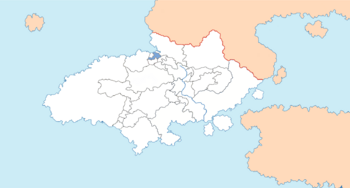Bishopric of Kirchmarkt and Teilen
Bishopric of Kirchmarkt and Teilen Bistum Kirchmarkt und Teilen (Alemannisch) | |
|---|---|
| 1267 | |
 | |
| Status | State |
| Capital | Kirchmarkt |
| Common languages | Alemannisch |
| Religion | Catholic Church |
| Demonym(s) | Kirchmarkter, Teilenner |
| Government | Theocratic parliamentary elective semi-constitutional monarchy |
• Bishop | Nikolaus Vogt |
| History | |
| 755 | |
| 1267 | |
| 1653 | |
Kirchmarkt and Teilen, officially the Bishopric of Kirchmarkt and Teilen (Allemanisch: Bistum Kirchmarkt und Teilen) is a semi-independent constituent state of Dolchland. Kirchmarkt and Teilen is located in the Drei Flüsse region of Dolchland. The state consists of two distinct but contiguous parts - the Church, City and Lands of Kirchmarkt and the County of Teilen, with the head of state, the Bishop of Kirchmarkt and Teilen, officially holding both titles. However, as they are intrinsically linked, and have been since the Land Grant of Teilen in 1653, both titles are counted as the unitary bishopric. The bishopric must not be confused with the Catholic Diocese of Kirchmarkt, which extends beyond the borders of the bishopric and over which the bishop exerts spiritual authority. The state is bordered by Bessen-Katzenelm and Tale-Flußstadt and Ersau to the east, Upper Streckeburg to the south, ($STATE) to the west and Lower Streckeburg to the north, as well as its own coastline on the Morthal Bay.
History
Foundation
The diocese of Kirchmarkt was founded in ($DATE) when the small village of Niedermarkt sent an envoy to ($POPE) requesting the sending of a legate and the creation of a church in the area. It is believed that this was requested to allow the peasantry further autonomy from the feudal/tribal overlords they previously swore fealty to. In any case, ($POPE) agreed to the terms, and in due course, a church was built in the area, with the market district of Niedermarkt coming to border the church lands, which did not extend far. Increasingly as time went on, the bishop of Kirchmarkt would take an interest in secular affairs, though it would remain unofficial and unrecognised by the monarch.
The diocese would come to further prominence in the ($WAR), during which the diocese, breaking from official Catholic church policy, supported the ($KING) against the rebelling ($DUKE) of Großtal openly, feeding and offering board to the loyalist armies. ($KING) did not forget the hospitality of the bishop, and in the Treaty of Kirchmarkt, raised numerous loyalist former-vassal states of the rebelling Duke of Großtal to the status of principalities, and the bishop's domain to that of a bishopric. The now-city of Niedermarkt-und-Kirch was formalised as the city of Kirchmarkt, which gave its name to the new bishop's domain.
Kirchmarkt and Teilen
Kirchmarkt developed further as a vassal, both secular and episcopal, of ($MONARCHY).
In 1648, the neighbouring Prince Benedikt of Streckeburg died, leaving the realm to his twin sons. However, a discrepancy between two maps, commissioned at different times during the Prince's reign, meant that a strip of land, quite sizeable and with prosperous hunting grounds, was claimed by both children. This threatened to escalate into a war between the brothers, neither of whom wanted to give up their claim over the land or divide it between them. ($KING) issued an ultimatum, stating that they were to resolve their dispute peacefully or the land would revert to the King and be passed to neither of them. It is believed that Prince Waldemar of Lower Streckeburg did not think this threat was serious. It is unclear whether Prince Sigismund of Upper Streckeburg thought the same, but the threat of conflict continued to escalate until 1653, when the forces of ($KING) entered Mittelsdorf, the largest settlement in the parcel of land, and asserted the King's claim over the land. He created within the land a new title, the County of Teilen, further clarifying that whatever claim the von Streckeburg brothers had over the land was now void, as the title-holder was to be the only claimant to the land. However, the King did not particularly want to govern the territory himself, and so wished to pass it off to a neighbouring lord. Given his poor relations with Wilhelm I of Lesser Vethringen to the west, as well as the mediatory role that the bishop of Kirchmarkt had taken in many local disputes to that point, the land was granted to the bishop and became inseparable from the remainder of the bishopric. The bishop voluntarily entered into the Treaty of Mittelsdorf with both Lower and Upper Streckeburg, offering residents of both lands access to the hunting grounds of Teilen without payment of the Episcopal Grounds Tax standard for hunters on church property at the time.
Geography
Location

Kirchmarkt and Teilen lies between three four rivers, which each comprise part of its natural borders. To the east, part of the border with Bessen-Katzenelm is demarcated by the Zott, though excluding the region of ($REGION) which lies on the western side of the Zott like Kirchmarkt. Kirchmarkt-proper has its borders with Lower Streckeburg, Teilen and Upper Streckeburg marked by the Unter. Finally, the western border of Kirckmarkt and Teilen, that lying between Teilen and Lesser Vethringen, is marked by the Weit, with its tributary, the Blatt, running through the centre of Teilen and making up part of its northern border with Lower Streckeburg. Kirchmarkt and Teilen is the only state within the Drei Flüsse region that has contact with all three rivers.

